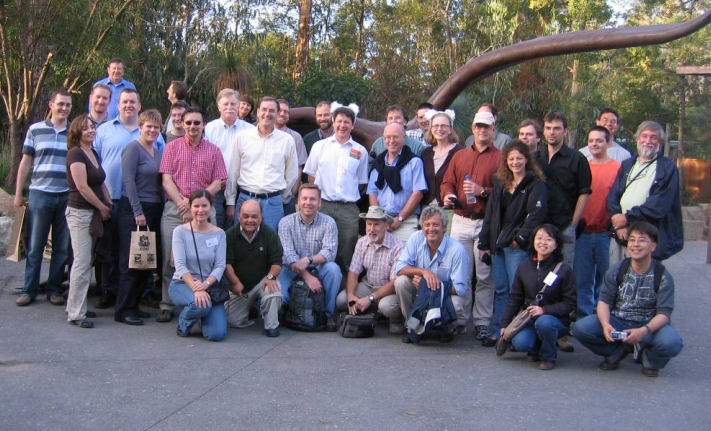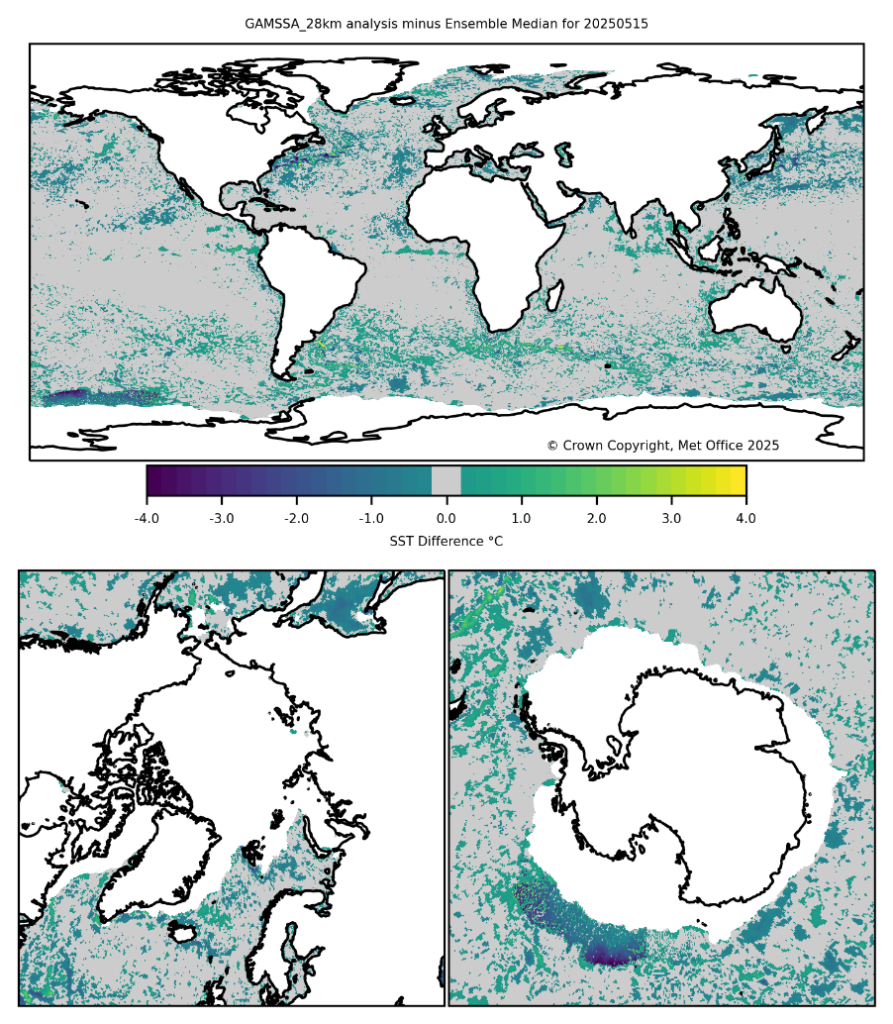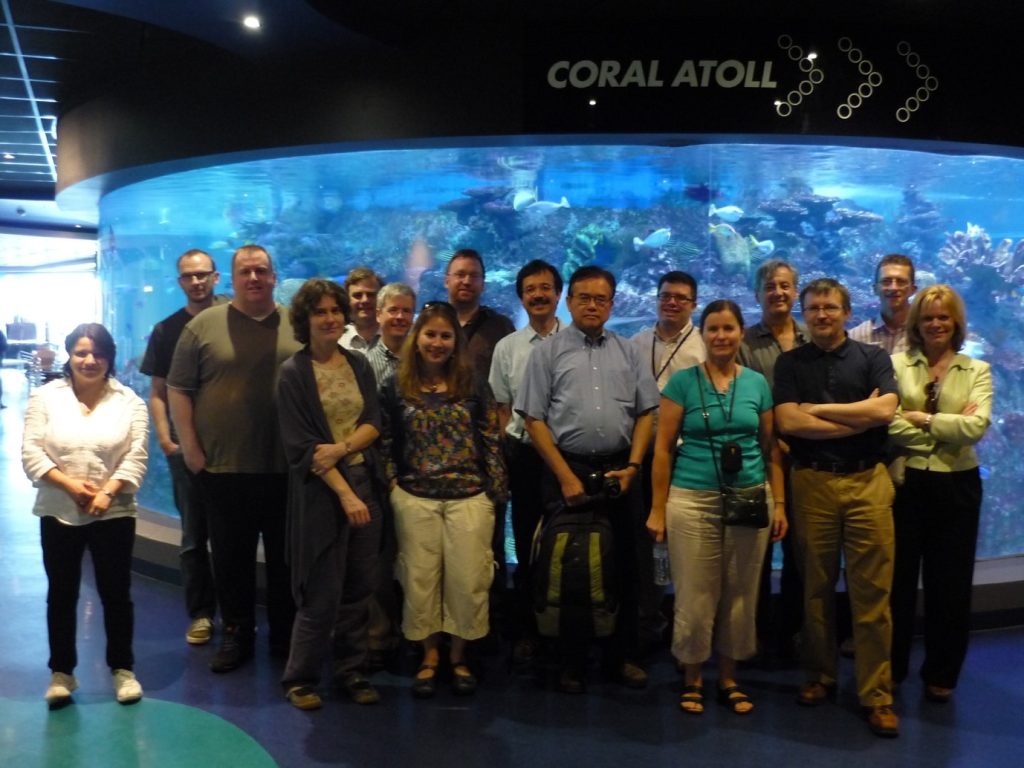As Helen Beggs, a long-standing GHRSST Science Team Member, marks her retirement from the Bureau of Meteorology, she reflects on more than two decades of involvement with GHRSST – from her first Science Team meeting in Townsville in 2004 to leading contributions in SST product development, inter-comparison efforts, and capacity-building across Australia and beyond. In this post, Helen shares the milestones, collaborations, and personal highlights that have shaped her 21-year GHRSST journey.
My 21-Year GHRSST Journey
Helen Beggs, formerly Bureau of Meteorology, Melbourne, Australia. Helen.Beggs@iinet.net.au
19th May 2025
My first encounter with GHRSST was when I attended the Fifth GODAE (Global Ocean Data Assimilation Experiment) High Resolution Sea Surface Temperature (SST) Pilot Project (GHRSST-PP) Science Team Meeting (GHRSST-V) in Townsville, Australia, in July 2004. I had been employed in 2003 by the Bureau of Meteorology (Bureau) in Melbourne, Australia, to develop a new foundation (pre-dawn) SST analysis for the Bluelink Forecasting Australia Project, to improve the Bureau’s Numerical Weather Prediction (NWP) forecasts. Neville Smith, then Director of GODAE and the Bureau’s Ocean Science Team Leader, insisted that it was essential for my research that I attend GHRSST-V, so I travelled to Townsville with husband, Brad, 4-month-old son David, and 5-year-old son, Glenn. At GHRSST-V I was delighted by the collegial and welcoming atmosphere of the meeting and the generous advice that was offered regarding design of foundation SST analyses.

GHRSST-V Meeting, Townsville, Australia, 2004
The following year, I travelled to Exeter, UK, to attend GHRSST-VI, and it was here that I was particularly struck by the value of GHRSST activities and meetings, and the time spent on discussing important issues such as SST definitions, data formats and dissemination. It was thrilling to be involved in an international effort to improve SST products, and be invited by the GHRSST-PP Science Team Chair, Craig Donlon, to join the Science Team to represent the Bureau. One of my first Science Team tasks was to collaborate in the development of the GHRSST Data Specification (GDS) for Level 4 (L4) SST analyses, which was much discussed at the 2006 GHRSST-VII meeting in Boulder, USA. The meeting also facilitated collaboration on the first of several GHRSST papers (Donlon et al., 2007, 2009; O’Carroll et al., 2019).
Hosting the GHRSST-VIII meeting in May 2007 at the Bureau’s Head Office in Melbourne was a great opportunity to introduce my Bureau colleagues to GHRSST, and foster long-term collaborations.

GHRSST-VIII Meeting, Melbourne, Australia, 2007
Shortly after the meeting, the Bureau released one of the first operational L4 products in GHRSST format, the Regional Australian Multi-Sensor SST Analysis (RAMSSA; Beggs et al., 2011). This daily, 1/12° resolution foundation SST analysis was formed using SST data from in-situ platforms and AMSR-E, AATSR and AVHRR satellite sensors. As well as sparse, global 8.8 km resolution AVHRR data from NESDIS, we used the direct broadcast 1.1 km resolution HRPT (High Resolution Picture Transmission) AVHRR data received by Australian ground stations. But there unfortunately were several issues with the SST data available at the time around Australia. There were few real-time observations from ships in 2006, and these were not from calibrated sensors (Beggs et al., 2012a). Also, the Australian HRPT AVHRR SST data had high uncertainty and were in formats difficult for users to use. I therefore applied for Australian Integrated Marine Observing System (IMOS) funding to start two IMOS sub-facilities in July 2007 to produce improved ship SST and satellite GHRSST-format SST products. To date, the Bureau through IMOS have provided 39 GHRSST-format high-resolution SST products over the Australian and Southern Ocean regions (Beggs and Govekar, 2022) with several available through the GHRSST Data Catalogue and Australian Ocean Data Network.
The advice from GHRSST Science Team members (Bill Emery, Ian Barton, Craig Donlon, Werenfrid Wimmer and Peter Minnett) was invaluable with regards to optimum ship SST sensor selection and system design for satellite SST verification (Beggs et al., 2012a; 2017). Extensive collaborations with other GHRSST colleagues (Andy Harris, Eileen Maturi, Jon Mittaz, Chris Merchant and Owen Embury) were critical for developing IMOS SST data sets from geostationary satellites MTSAT-1R (Zhang et al., 2016) and later Himawari-8 and -9 (Govekar et al., 2024). In addition, collaboration with Sasha Ignatov’s NOAA SST Team helped us ingest NOAA’s VIIRS GHRSST Level 3 Uncollated (L3U) SST data into the IMOS Level 3 Super-collated (L3S) Multi-sensor SST products (Govekar et al., 2022) and the Bureau’s operational L4 products (Beggs et al., 2020).
In July 2008, the Bureau released its second GHRSST-format L4 product, GAMSSA (Global Australian Multi-Sensor SST Analysis (Beggs et al., 2020; Zhong and Beggs, 2008). This joined a growing list of operational GHRSST L4 global daily gap-free products, which were combined by the Met Office to form the GHRSST Multi-Product Ensemble (GMPE, Martin et al., 2012) and compared in near real-time by Met Office and NOAA SQUAM (Dash et al., 2012) web tools. Shown here is a near-real time image produced by the Met Office of GAMSSA minus the GMPE SST. Such images available from these Met Office and NOAA web tools are valuable for identifying and diagnosing issues with operational SST analyses. Both GAMSSA and RAMSSA L4 files are available in near-real time from the NASA GHRSST Data Assembly Centre (PO.DAAC) and the Australian Ocean Data Network.

GAMSSA minus GMPE Median SST for 15th May 2025 (Accessed 17th May 2025 from https://ghrsst-pp.metoffice.gov.uk/ostia-website/gmpe-monitoring.html)
GHRSST-PP held a side-meeting on SST Diurnal Variation (DV) at the Ocean Sciences Meeting in March 2008, Orlando, USA. It was here from discussions that I held with Chris Merchant, Sandra Castro and Gary Wick, that the germ of an idea was born for the GHRSST Tropical Warm Pool Diurnal Variability (TWP+) Dataset. The TWP+ dataset would comprise hourly 5 km geostationary satellite SST data (from MTSAT-1R) and the Bureau’s regional, 0.375° horizontal resolution, NWP hourly forecast meteorological and flux data on a common 0.05° grid and study period (1st January to 30th April 2010), to compare DV models over the region 90°E – 170°E, 25°S – 15°N. The chosen TWP+ domain captures much of the hottest mean SSTs on the globe (Zhang et al., 2016).
TWP+ Project discussions continued at GHRSST-IX in Perros-Guirrec, France, in February 2009 at the 5th GHRSST Diurnal Variability Working Group Meeting in Rome, and in March 2012 at the GHRSST Joint Working Group Workshop in Melbourne (Keiser-Weiss et al., 2012). The aim of the 2012 Workshop was to achieve progress with the observed and modelled sea surface temperatures for two regions – the Tropical Warm Pool and High Latitudes (concentrating on the Southern Ocean). It allowed detailed discussions around collection of the TWP+ dataset (Beggs et al., 2012b) and comparisons of this dataset with DV models (Castro et al., 2012).

GHRSST Joint Working Group Workshop, Melbourne, Australia, 2012
After my postgraduate student, Haifeng Zhang, started his PhD studies at UNSW in Canberra, Australia, in 2014, the IMOS MTSAT-1R SST data set was assessed for its suitability to quantify DV events over the TWP+ domain (Zhang et al., 2016) and several more SST diurnal variation models were evaluated over the Tropical Warm Pool region (Zhang et al., 2018). Haifeng presented his TWP+ results at GHRSST-XIX in Darmstadt, Germany.
In November 2015, in collaboration with Gary Corlett, CEOS SST Virtual Constellation, GHRSST Project Office and IMOS, I hosted the first Satellite Oceanography Users Workshop at the Bureau of Meteorology’s Melbourne Office aimed at users of satellite-derived products of three key oceanographic variables (SST, Ocean Colour and Sea Surface Height). The objectives of the 3-day workshop (Beggs et al., 2015) were to:
- Present and discuss the provision of products and services supporting satellite-based ocean products;
- Provide a forum for users to present and discuss their experiences and requirements on satellite-based ocean products; and
- Work through practical examples of particular interest to participants.
Assisting users to select the most appropriate SST products for their applications has been a particular interest of mine since 2009 (e.g., Beggs, 2010; 2021; Beggs et al., 2018; GHRSST Project Office et al., 2023).

Satellite Oceanography Users Workshop, Melbourne, Australia, 2015
GHRSST-XVIII in 2017 was hosted by Prof. Lei Guan of Oceans University of China (OUC) in Qingdao, China, and it was here that I met my future PhD student, Yuwei Hu, who went on to study Marine Heatwaves around Australia’s coasts using remotely sensed SST and sea surface height (Hu et al., 2024). I also met an OUC postgraduate student of Lei Guan’s, Minglun Yang, who collaborated with GHRSST Science Team members from JAXA (Misako Kachi and Yukio Kurihara) and I to validate JAXA’s Himawari-8 GHRSST L2P SST data using the IMOS skin and depth SST observations from Australian research vessel RV Investigator (Yang et al., 2020).
During GHRSST-XIX in Darmstadt, Germany (June 2018), I proposed the GHRSST SST Climatology Inter-Comparison Task Team, which in June 2019 at GHRSST-XX in Frascati, Italy, was expanded to include L4 SST Analysis inter-comparisons. Chunxue Yang (CNR, Italy) became my co-chair and led the sub-task to produce the valuable inter-comparison of eight long-term global SST analyses to assess their suitability for climate analysis (Yang et al., 2021).
The Global Pandemic in 2020 forced all GHRSST Science Team and Task Team meetings online, which allowed wider participation of students and scientists who would not normally travel to a GHRSST meeting. Although I missed face-to-face contact with GHRSST colleagues, the GHRSST Inter-Comparison Task Team was able to keep in touch from July 2020 via regular bi-monthly virtual meetings. After three years of virtual GHRSST meetings, however, it was very exciting for my Bureau colleague, Pallavi Govekar, and I to meet in-person again with some of the GHRSST Science Team in October 2023 at GHRSST-24 in Ahmedabad, India. It was great to hear about exciting new Ultra High-Resolution satellite missions like TRISHNA and catch up with GHRSST colleagues.
Immediately after GHRSST-24 Pallavi Govekar joined the GHRSST Science Team, followed in 2024 by another Bureau colleague, Haifeng Zhang. Pallavi now leads the IMOS Satellite Remote Sensing SST Products Sub-Facility, and Haifeng the IMOS SST sensors for Australian Vessels Sub-facility.

Australian members of the GHRSST Science Team (left to right) – Pallavi Govekar, Helen Beggs and Haifeng Zhang.
With my retirement from the Bureau of Meteorology in March 2025, my operational and research involvement in GHRSST comes to an end, but I hope to keep in touch. The GHRSST Meetings were the highlight of my 22 years at the Bureau. My SST-related research for the Bluelink and IMOS projects at the Bureau would not have been possible without the many generous collaborations with GHRSST colleagues, and access to GHRSST data sets and online tools. I wish my GHRSST colleagues the very best for their efforts in improving the accuracy and availability of SST products, and their application and research.
References
Beggs H. (2010) Use of TIR from Space in Operational Systems, In: Oceanography from Space Revisited, Ed. V. Barale, J.F.R. Gower and L. Alberotanza, Pub. Springer Science+Business Media B.V. pp. 249-271. DOI 10.1007/978-90-481-8681-5 https://www.researchgate.net/publication/259823623_Use_of_TIR_from_Space_in_Operational_Systems
Beggs H., A. Zhong, G. Warren, O. Alves, G. Brassington and T. Pugh (2011) RAMSSA – An Operational, High-Resolution, Multi-Sensor Sea Surface Temperature Analysis over the Australian Region, Australian Meteorological and Oceanographic Journal, 61, 1-22. http://www.bom.gov.au/jshess/papers.php?year=2011
Beggs H., R. Verein, G. Paltoglou, H. Kippo and M. Underwood (2012a) Enhancing ship of opportunity sea surface temperature observations in the Australian region. Journal of Operational Oceanography (ISSN: 1755-8778), 5, 59-73.
Beggs Helen, Sandra Castro, Gary Wick, Leon Majewski, Pierre LeBorgne, Christopher Merchant, Michael Brunke, Carol–Ann Clayson, Xiaofang Zhu, Gary Corlett, Vaughan Barass, Chris Tingwell, Paul Sandery, Eric Schulz, George Kruger, Andrew Harris, Jon Mittaz, Chelle Gentemann and Owen Embury (2012b), Update on the GHRSST Tropical Warm Pool Diurnal Variability (TWP+) Project, In: Proceedings of the GHRSST XIII Science Team Meeting, Tokyo, 4 – 8 June 2012, p. 188-189. https://doi.org/10.5281/zenodo.4700637
Beggs, H., N. Morgan and J. Sisson (2017) IMOS Ship SST for Satellite SST Validation, In: Proceedings of the GHRSST XVIII Science Team Meeting, Qingdao, China, 5th – 9th June 2017, ISSN 2014-2529, p. 127-134. https://doi.org/10.5281/zenodo.4700225
Beggs, Helen, Christopher Griffin, Pallavi Govekar, Leon Majewski, Lixin Qi and Aihong Zhong (2018) Which IMOS GHRSST product should I use? Presented at the IMOS Data Workshop, AMSA 2018 Conference, Adelaide, Australian, 6th July 2018. https://imos.org.au/wp-content/uploads/2024/07/IMOS_Data_Workshop-SST-Beggs_08Jul2018-1.pdf
Beggs, Helen, Lixin Qi, Pallavi Govekar and Christopher Griffin (2020) Ingesting VIIRS SST into the Bureau of Meteorology’s Operational SST Analyses, In: Proceedings of the 21st GHRSST Science Team Meeting, Virtual Meeting hosted by EUMETSAT, 1st – 4th June 2020. p. 104-110 Zenodo. https://doi.org/10.5281/zenodo.4626734
Beggs, Helen (2021). Temperature. Ch 14 in Earth Observation: Data, Processing and Applications. Volume 3B: Applications—Surface Waters. CRCSI, Melbourne. pp. 245–279. ISBN 978-0-6482278-5-4. https://www.eoa.org.au/earth-observation-textbooks (Published online 21 Dec 2021)
Beggs, Helen and Pallavi Govekar (2022) Gridded Sea Surface Temperature Observations, Bureau of Meteorology Fact Sheet, Bureau of Meteorology, Docklands, Vic, Australia, 11th August 2022, 2 pp. https://imos.org.au/fileadmin/user_upload/shared/SRS/SST/BoM_Satellite_SST_-_FactSheet_-_20220811.pdf
Castro, S., G. Wick and H. Beggs (2012) Comparisons of observed and predicted diurnal warming in the Tropical Warm Pool using simplified parameterizations, Presented as a poster at the 2012 Ocean Sciences Meeting, Salt Lake City, Utah, 19-24 February, 2012.
Dash, P., A. Ignatov, M. Martin, C. Donlon, B. Brasnett, R. Reynolds, V. Banzon, H. Beggs, D. May, B. McKenzie, J-F. Cayula, Y. Chao, R. Grumbine, E. Maturi, A. Harris, J. Mittaz, J. Sapper, T. Chin, J. Vazquez, E. Armstrong, C. Gentemann, J. Cummings, F-F. Piolle, E. Autret, J. Roberts-Jones, S. Ishizaki, J. Hoyer, D. Poulter (2012) Group for High Resolultion SST (GHRSST) Analysis Fields Inter-Comparisons Part 2. Near real-time web-based Level 4 SST Quality Monitor (L4-SQUAM). Deep Sea Research II, 77-80, 31–43. https://www.sciencedirect.com/science/article/abs/pii/S0967064512000501
Donlon, C., I. Robinson, K. Casey, J. Vasquez, E. Armstrong, C. Gentemann, D. May, P. LeBorgne, J. Piolle, I. Barton, H. Beggs, D. J. S. Poulter, C. Merchant, A. Bingham, S. Heinz, A. Harris, G. Wick, B. Emery, A Stuart-Menteth, P. Minnett, B. Evans, D. Llewellyn-Jones, C. Mutlow, R. Reynolds, H. Kawamura and N. Rayner (2007) The Global Ocean Data Assimilation Project (GODAE) High Resolution Sea Surface Temperature Pilot Project (GHRSST-PP), Bull. Am. Met. Society, 88, 1197-1213. https://journals.ametsoc.org/view/journals/bams/88/8/bams-88-8-1197.xml
Donlon, C., K. Casey, I. Robinson, C. Gentemann, R. Reynolds, I. Barton, O. Arino, J. Stark, N. Rayner, P. Le Borgne, D. Poulter, J. Vazquez-Cuervo, E. Armstrong, H. Beggs, D. Llewellyn-Jones, P. Minnett, C. Merchant and R. Evans (2009) The GODAE High-Resolution Sea Surface Temperature Pilot Project, Oceanography, 22, 34-45. https://tos.org/oceanography/assets/docs/22-3_donlon.pdf
GHRSST Project Office, Beggs, H., Karagali, I., & Castro, S. (2023). Sea surface temperature: An introduction to users on the set of GHRSST formatted products. Zenodo. https://doi.org/10.5281/zenodo.10539712
Govekar, Pallavi, Christopher Griffin and Helen Beggs (2022) Multi-sensor Sea Surface Temperature products from the Australian Bureau of Meteorology, Remote Sensing, 2022, 14, 3785. (6 August 2022) https://doi.org/10.3390/rs14153785
Govekar, Pallavi, Christopher Griffin, Owen Embury, Jon Mittaz, Helen Beggs and Christopher Merchant (2024) Himawari-8 Sea Surface Temperature products from the Australian Bureau of Meteorology, 16, 3381. https://doi.org/10.3390/rs16183381.
Hu, Yuwei, Xiao Hua Wang, Helen Beggs and Chunzai Wang (2024) Intrinsic short Marine Heatwaves from the perspective of sea surface temperature and height, Weather and Climate Extremes, Vol. 46, 100725, ISSN 2212-0947, https://doi.org/10.1016/j.wace.2024.100725
Kaiser-Weiss, A., Beggs, H., Høyer, J. L., Harris, A., Gary, C., & Wick, G. (2012). Summary of the Joint Workshop of the DV-WG, HL-TAG, ST-VAL, and EARWiG on Tropical Warm Pool and High Latitude SST Issues. https://doi.org/10.5281/zenodo.15101252
Martin M., P. Dash, A. Ignatov, V. Banzon, H. Beggs, B. Brasnett, J-F. Cayula, J. Cummings, C. Donlon, C. Gentemann, R. Grumbine, S. Ishizaki, E. Maturi, R. Reynolds, J Roberts_Jones (2012) Group for High Resolution SST (GHRSST) Analysis Fields Intercomparisons: Part 1. A GHRSST Multi-Product Ensemble (GMPE). Deep Sea Research II, 77-80, 21–30. http://dx.doi.org/10.1016/j.dsr2.2012.04.013
O’Carroll, A.G., Armstrong, E.M., Beggs, H., Bouali, M., Casey, K.S., Corlett, G.K., Dash, P., Donlon, C.J., Gentemann, C.L., Hoyer, J.L., Ignatov, A., Kabobah, K., Kachi, M., Kurihara, Y., Karagali, I., Maturi, E., Merchant, C.J., Minnett, P., Pennybacker, M. Ramakrishnan, B., Ramsankaran, R., Santoleri, R., Sunder, S., Saux Picart, S., Vazquez-Cuervo, J., Wimmer, W. (2019) Observational needs of sea surface temperature, Frontiers in Marine Science – Ocean Observations, 20th August 2019. https://doi.org/10.3389/fmars.2019.00420
Yang, Chunxue, Francesca Elisa Leonelli, Salvatore Marullo, Vincenzo Artale, Helen Beggs, Bruno Bunogiorno Nardelli, Toshio Michael Chin, Vincenzo De Toma, Simon Good, Boyin Huang, Christopher J. Merchant, Toshiyuki Sakurai, Rosalia Santoleri, Jorge Vazquez-Cuervo, Huai-Min Zhang, Andrea Pisano (2021) Sea Surface Temperature intercomparison in the framework of the Copernicus Climate Change Service (C3S), J. Climate, 33(13), 5257-5283; https://doi.org/10.1175/JCLI-D-20-0793.1
Yang, Minglun, Lei Guan, Helen Beggs, Nicole Morgan, Yukio Kurihara and Misako Kachi (2020). Comparison of Himawari-8 AHI SST with Shipboard skin SST measurements in the Australian Region, Remote Sensing, 12(8), 1237; https://doi.org/10.3390/rs12081237
Zhang H., H. Beggs, L. Majewski, X.H. Wang, A. E. Kiss (2016) Investigating Sea Surface Temperature Diurnal Variation over the Tropical Warm Pool Using MTSAT-1R Data. Remote Sensing Environment, 183, 1-12. http://www.sciencedirect.com/science/article/pii/S003442571630195X
Zhang H., H. Beggs, X. H. Wang, J. Rodriguez, A. L. Thorpe, M. Brunke, L. Majewski, A. E. Kiss, C. Gentemann (2018) Comparison of SST Diurnal Variation Models over the Tropical Warm Pool, J. Geophys. Res. Oceans, 123, http://dx.doi.org/10.1029/2017JC013517
Zhong, Aihong and Helen Beggs (2008) Analysis and Prediction Operations Bulletin No. 77 – Operational Implementation of Global Australian Multi-Sensor Sea Surface Temperature Analysis, Bureau of Meteorology, Melbourne, Australia, 2 October 2008. http://www.bom.gov.au/australia/charts/bulletins/apob77.pdf
